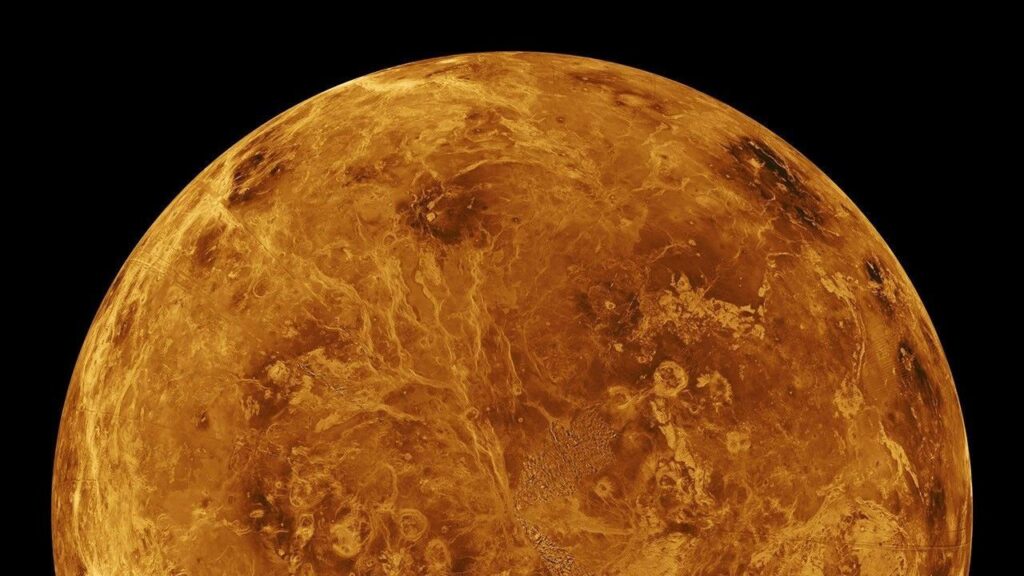
A groundbreaking study sheds light on the enigmatic geological features of Venus known as coronae, which are large, crown-like formations on the planet’s surface. Researchers propose that a layer of material in Venus’ mantle, referred to as a “glass ceiling,” is responsible for trapping heat and driving slow currents that lead to the formation of these distinctive features.
Lead author Madeleine Kerr, a doctoral candidate at the University of San Diego’s Scripps Institution of Oceanography, expressed that their findings could be crucial for understanding the origin of these geological structures. “On Venus, there is a pattern that is telling us something,” she stated.
Venus and Earth are often called “twin” planets due to their similar size and distance from the sun. Yet, their evolutionary paths diverged significantly, resulting in vastly different surfaces. The coronae, unique to Venus, have puzzled scientists for years. More than 700 coronae have been mapped, varying in size and characteristics. However, the lack of tectonic plate movement on Venus complicates their origins, as the planet features a continuous crust unlike Earth.
Some hypotheses suggest that larger coronae, those exceeding 310 miles (500 kilometers) in diameter, may be linked to mantle plumes and tectonic processes. In contrast, smaller coronae, averaging 124 miles (200 kilometers) in diameter, might result from localized hot upwellings in the mantle. The study, published on September 16, 2023, in the journal PNAS, highlights the difficulty in substantiating these theories.
According to David Stegman, a professor of geosciences at the Scripps Institution, the current understanding of Venus resembles the pre-plate tectonic era of the 1960s. “We currently lack an equivalent unifying theory capable of linking how heat transfer from the planet’s interior manifests in the tectonics and magmatic features observed on Venus’ surface,” he explained.
The researchers now believe they have uncovered a vital component of the puzzle. They propose that cold material sinking from the surface encounters a barrier at a depth of about 370 miles (600 kilometers). This “glass ceiling” prevents most rising hot plumes from breaking through, causing them to spread sideways beneath the surface. Only the largest plumes can reach the surface and form massive volcanic structures.
The material trapped beneath this layer remains warm but does not melt, acting as a hidden reservoir of heat within the mantle. The team asserts, “This layer of warm fluid trapped between 600 to 740 kilometers [370 to 460 miles] depth provides a global source of smaller-scale thermal instabilities.”
Using computational models, the researchers demonstrated how these small-scale plumes could form naturally. A cold “drip” of rock from the base of Venus’ stagnant crust cools, becomes denser, and sinks into the hotter mantle below. This process triggers a chain reaction, pushing up several pockets of hot rock, contributing to the formation of coronae.
Unlike previous studies that started with these hot blobs already present, this research provides a plausible natural origin for those initial conditions. As secondary plumes rise, melt, and eventually sink again, they interact with the mantle, potentially explaining the diverse coronae observed on Venus.
The models indicate that this mechanism operates when the mantle is 250 to 400 kelvins hotter than that of Earth. However, the duration of such a state remains uncertain.
The authors emphasize that further research is necessary. Future studies should model plume dynamics in three dimensions, consider melting processes both within the mantle and on the surface, explore various mantle compositions, and track changes over the history of Venus. These efforts will enhance understanding of how Venus’ internal heat influences the formation of coronae, volcanoes, and its overall surface characteristics.







